When thinking about survival situations, food is always a priority. Sure you can hunt, fish, or gather food. However, having food available for bugging in or bugging out is an even better option.
In my endless hunt for survival foods, I am primarily looking to fulfill a few needs. One is that the food must last a long time.
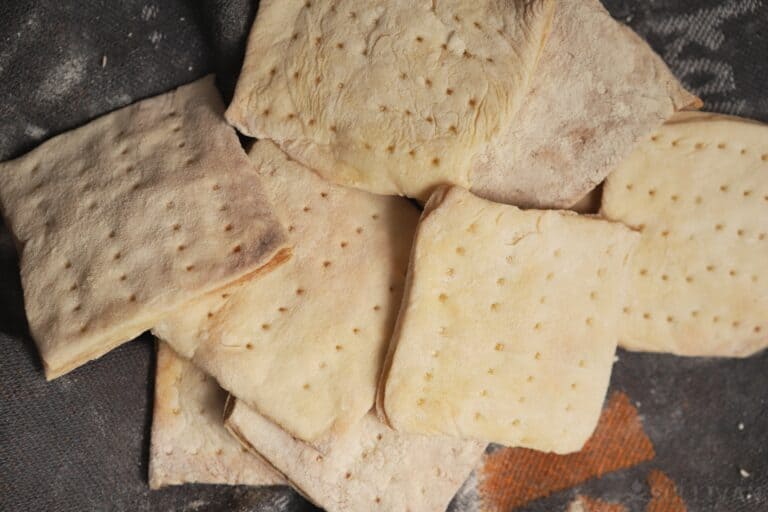
Another is that it must be lightweight and compact. A third would be that it must satisfy some dietary need that is hard to fulfill otherwise.
Hardtack is basically a dried biscuit that fits the profile of a good survival food.
How Long Will Hard-Tack Last?
In short, hard-tack will last for at least 5 to 10 years, but in theory, the shelf life is indefinite. There are claims of over 50 yes of shelf life, given that it was eaten by soldiers during wars.
If kept dry, hardtack can last for decades, so it is ideal for your pack or your food stockpile.
Of course, you want to rotate it, instead of just relying on 10 year old hardtack. This will give you a chance to try it out and make some more.
The main thing that affects hardtack’s shelf life is moisture.
Because it is dried, it is compact and lightweight. It is also high in calories and carbohydrates. Those are two commodities that are hard to come by in a survival situation. Another benefit of hardtack is that it is easy to make in almost any conditions.
Now, the process of making this food is incredibly simple. This is one of the reasons it makes for a great survival food. You can make hardtack with only two ingredients by skipping the salt.
Here’s What You’ll Need
- Bowl: a medium sized mixing bowl is all you need to combine your wet and dry ingredients into a dough.
- Fork: you’ll need a fork only to poke holes into the dough immediately prior to baking. This ensures even, quick cooking.
- Rolling Pin: hardtack dough might be really basic, but you still need a rolling pin to press it out into a uniform thickness or even, proper baking. Any kind of rolling pin will work here, and if you don’t have one you can use a tin can wrapped in foil.
- Knife: any kind of knife at all is more than adequate for cutting your hardtack dough into squares or other shapes.
- Spatula: for flipping the biscuits halfway through cooking.
- Cooling rack: I know this seems like a luxury, but you really do need a cooling rack to make hardtack properly. You’ve got to let it cool down to room temperature prior to storing in order to prevent moisture from accumulating in a sealed container. Letting it cool on a flat surface can trap moisture underneath and facilitate spoilage! A cheap one works fine.
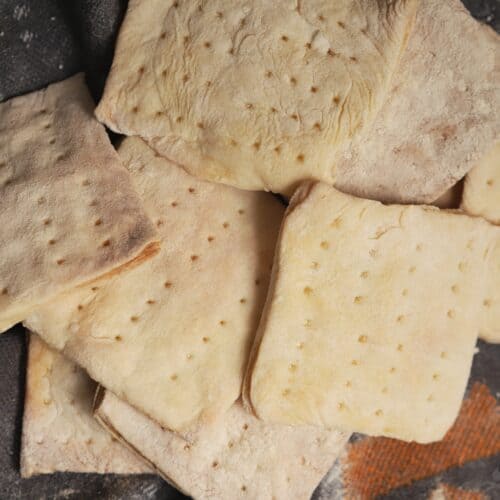
Basic Hardtack Recipe
Equipment
- 1 bowl
- 1 fork
- 1 Rolling Pin
- 1 knife
- 1 spatula
- 1 cooling rack
Ingredients
- 5 cups flour that's 600 grams
- ½ cups water
- 3 teaspoons salt
Instructions
- Start with two cups of flour in a bowl, to which you add the salt.
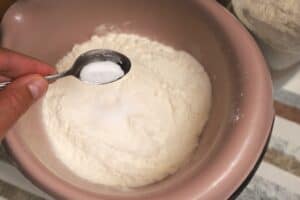
- Next, slowly add the water.
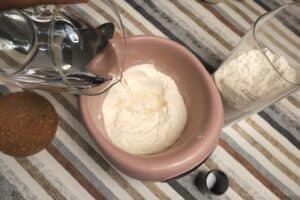
- Mix well. Your goal is to make it into a consistent dough that you can roll out and cut. If it gets too watery, add more flour.
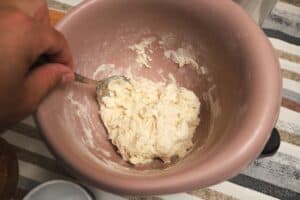
- On a floured table, roll out your dough with a floured rolling pin until it is about ¼ inch thick.
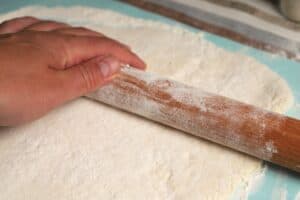
- Cut it into whatever shapes and sizes you like – typically 3×3 inch (7×7 centimeter) squares. It's important that all the pieces be roughly the same size so they cook at the same rate.
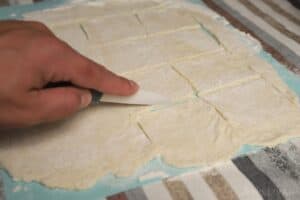
- Preheat the oven to 375 °F (190 °C).
- Place the biscuits on an ungreased baking sheet, and make sure they are evenly spaced.
- Next, dock the biscuits. This means poking holes in the dough so it will dry properly and will not rise. Folks usually cut 16 holes in a 3 inch by 3 inch square, but I poked more holes so they cook faster. Use your fork to keep them evenly spaced and sized.
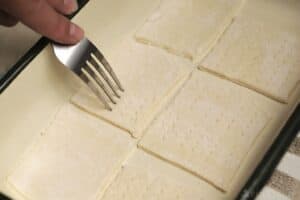
- Cook them for 20 to 30 minutes at 375 °F (190 °C).
- Flip them over with a spatula, then cook them for another 20 to 30 minutes.
- Remove the biscuits from the baking sheet, and place them on a cooling rack until they reach room temperature. Store in an airtight container.
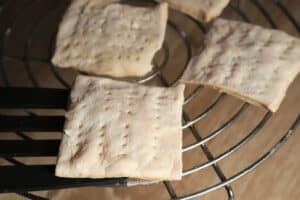
Notes
- There is no point in kneading the dough since we are not making bread.
- Think about storage and purpose when you cut the pieces. You will want larger pieces if you might use it as a plate for other food. If you’re packing it into a small space in a pack, you will likely want smaller pieces.
- You can use a ruler to cut a straight edge, or you can use cookie cutters, a jar, or a glass to cut various shapes.
- You can use a fork, a nail, chopsticks, or a knife to poke evenly spaced holes all the way through the dough.
Variations
Hard tack in this form has very little flavor. There are things you can do to make the finished product more flavorful.
However, keep in mind that the lack of moisture is what makes hardtack last as long as it does. You cannot modify the recipe in any way that adds moisture or it will spoil sooner.
Salt is an ingredient that was often added to hardtack. Not only does it add flavor, but the human body needs some level of salt in the diet to keep functioning.
Other grains can be added to the flour for texture and flavor. Spices can be added or a little honey can give your hardtack a sweet taste while also adding valuable sugars.
Dairy products like butter or cream can be added, but they will likely go rancid within a few weeks.
Check out our video with this survival crackers recipe variation:
Storage
There are two primary reasons why hard tack might not last as long as you would like. One would be if moisture gets to the biscuits. Any moisture can cause mold to form which would render the hardtack inedible.
You are best to keep your hardtack in an airtight container or bag. Store your containers in a cool, dry place to ensure it keeps as long as possible.
The other potential issue with hardtack is damage from pests. These biscuits are a perfect food source for bugs like weevils or for mice or rats.
If you get an infestation of weevils or other insect critters, this is typically due to inadequate containers which allow them to slip in or, just as likely, you already have contaminated flour in your pantry.
As a rule, you want to use the freshest and best flower you’ve got to make your hardtack because that will influence the longevity of the finished product.
For this reason you should try to keep your supply up off of the ground. I also prefer hard, airtight containers to keep out the insects and pests that could ruin my stash.
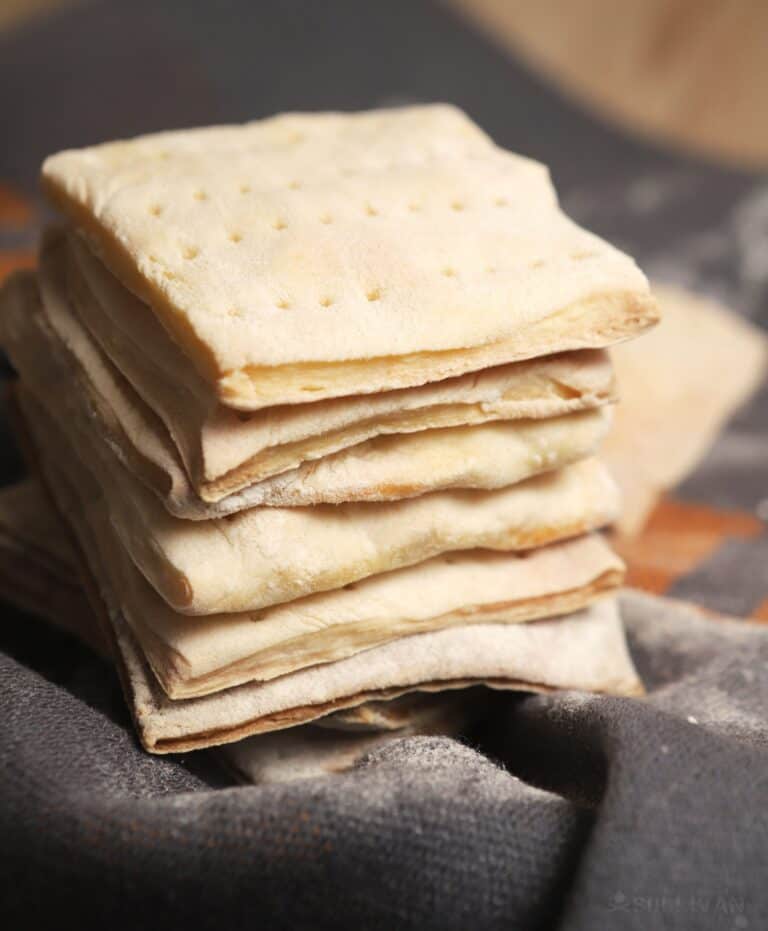
Caution: Hardtack Can Break Your Teeth!
I really must impress upon you that hardtack is not like a saltine cracker. Hardtack is hard; really, really hard! Like, as hard as a brick in some cases!
If you make the mistake of chomping into one of these biscuits unprepared you could chip one of your front teeth or shatter a molar, and that’s the last thing you want to deal with, especially in the middle of a survival situation.
Yes, it is possible to slowly, gently gnaw on hardtack in order to soften it up and nibble off small pieces to soften in your mouth, but you’ll have a much better time of things if you properly prepare it prior to eating. I’ll tell you about that in the next section.
How to Eat Hardtack
With most recipes there is no need for a section on how to eat the finished product. However, hardtack is an exception. As mentioned, the biscuits are so hard that you often have to get a bit creative to find a safe way to eat it.
Soak
One way or the other, if you’re going to eat hardtack directly, it has to be softened…
One way to do this with no other preparation is to snap off a tiny piece, pop it into your mouth and then let it soften enough so that you can safely chew it and then swallow it. Be warned, this stuff will parch you since it is as dry as Death Valley. Have a drink close at hand.
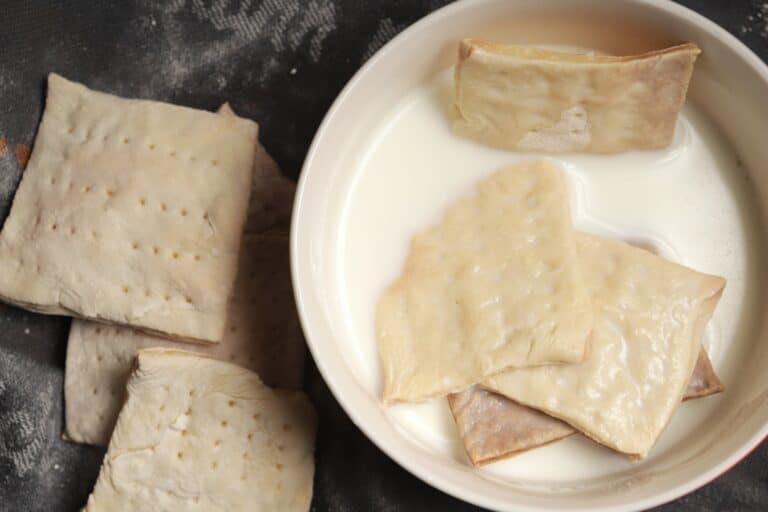
Another way is to dip a biscuit in liquid, coffee or tea works well, and then eat it once it has softened substantially. You can also snap off hunks into croutons sizes and put them in a hot stew or soup to eat it that way, but make damn sure it is really soft before you bite down on it!
Crush
Speaking of soups and stews, one popular way to eat hardtack and one that was employed constantly in historical settings, it simply to crush it with any sturdy tool into a bread crumb-like consistency and then it mix it in with another dish. Tiny pieces like this will absorb moisture quickly and soften even quicker.
If you’re eating soup or stew, you can also use it as a thickener to add calories and bulk up an existing meal. This is especially helpful if you don’t want to waste a lot of time softening individual pieces or biscuits for consumption.
Fry
My personal favorite way to eat hardtack, and also a way to add even more calories, is to fry it up. If you have enough oil to do some proper deep frying, you can simply dip hard tack and cold oil and then pop it in the hot oil to fry. This will soften it and also give it a tasty flavor and texture that is something like fry bread if you’ve ever had that.
An easier and quicker method is to simply pan fry. Soak a biscuit or two until just soft enough to cut then slice it into evenly sized strips before pan-frying it golden on each side. Take care to avoid splattering because introducing any kind of water content to a pan of hot oil will cause it to splash, spit and sizzle.
As Porridge
A great way to use hardtack without risking your chompers is as part of porridge. Crushed or chunked hardtack can be added to gravy to give it some interesting texture and increase the calories of a dish, or you can mix it in with milk, syrup, butter and then simmer it to make a thick dish that tastes a little bit like oatmeal.
This is another one of my favorites and a good way to make use of your hardtack quickly.
Variations
Hard tack in this form has very little flavor. There’s bland, there’s bland, and then there’s hardtack! This stuff will keep you alive but you might wish for death if you are forced to subsist on it alone. Luckily, there are things you can do to make the finished product more flavorful.
Before you add anything, keep in mind that the lack of moisture is what makes hardtack last as long as it does. You cannot modify the recipe in any way that adds moisture or it will spoil sooner.
For starters, you can just add a little more salt to make it savory. Salt is an ingredient that is always added to hardtack, but a little extra beyond what the recipe above calls for is fine. Not only does it add flavor, but the human body needs some level of salt in the diet to keep functioning.
Spices and herbs are one of the best ways to give your hard tack a little bit of flavor without dramatically affecting its shelf life is to use various spices and herbs. This is also awesome if you plan on adding the hardtack to other dishes like soups, stews, and so forth.
For instance, adding some mixed Italian herbs to the recipe will give it a tasty crouton-like flavor that is perfect and all kinds of soups. Cinnamon and nutmeg gives it a more dessert-like profile, and lends it better to a variety of breakfast preparations.
The trick is that you only want to add a small amount to the recipe above, no more than a tablespoon, and know that even though spices are dried they still contain volatile oils which can go rancid and accordingly spoil your hardtack.
Make no mistake, it can still last for a very long time but if you were planning on putting it away and it being fine in 15 years, you probably want to stick with the original recipe.
Sugar is another common inclusion in hardtack recipes, and one that will improve both the texture and the flavor which is very lacking as mentioned. But, sugar is at best a highly contentious inclusion: adding sugar generally increases the likelihood of spoilage, especially brown sugar which contains molasses and accordingly much higher levels of moisture.
Rules of thumb: you can add a teaspoon of white sugar and get at least a year or two out of your hardtack recipe in ideal conditions, but if you’re adding brown sugar you want to eat it in a year or less. Don’t count on brown sugar hardtack to go any longer in storage.
If you are going to eat hardtack without preparing it in some way, there is a proper way to do it. Break off a small piece and let it sit in your mouth to soften for a while. Eventually, you’ll get a softer consistency that you can chew. Also be sure to have some water on hand as the flour will suck all the moisture out of your mouth.
History
This survival food has a long and proud history of proving its value. Both the ancient Roman and the ancient Egyptian civilizations used hardtack, and typically gave it to their soldiers as rations. It is ideal as a ration for soldiers for the same reasons it is ideal for survival situations.
Sailors crossing vast oceans would take hardtack with them for the journey. It was baked four times to be sure it would survive the moisture from the sea.
Often the biscuits would have to be soaked in pickle brine, coffee, or water to soften them enough to eat.
Civil War soldiers were rationed several large biscuits per day and often used them as plates to eat perishable food. They would then snack on the biscuits as they hiked.
The Union Army would bake the biscuits twice and then let them sit for six months before issuing them to soldiers. This would ensure they were properly dried.
Southern states were short on flour because of blockades put in place by the North, so when flour was available they made huge batches.
In Conclusion
The more time that passes as a survivalist and prepper, the more I think about things like food preservation. Whether we are talking about venison, fish, berries, mushrooms, or hardtack, it appears that dehydration is the key to long term preservation.
Keeping food cold is fine in certain circumstances. However, without electricity there are times that keeping food cold is very difficult.
By removing the moisture from a food, you eliminate the possibility of fungus or bacteria growing in that food. That is all that hardtack is. It is a form of bread with all of the moisture removed.
In addition to lasting years and years, this survival food is lightweight and versatile. It’s perfect to add to your bug out bag or to save for times when other food is not available. here are dozens of ways to make and prepare hardtack to give you a variety of flavors and textures.
There’s a good reason why soldiers and seamen have carried hardtack for thousands of years. When you are pushed to the limit and need vital energy, it is a great option for a snack.
Over the years hardtack has been known as pilot bread, cabin bread, ship biscuit, sea biscuit, and sea bread. It has had so many nicknames because of how prolific it has been in the survival of man in the worst possible conditions.
Not only do I like to keep some around the house, but I always like to take some with me on any camping or hiking trips. If you get a chance, make some up and integrate it into your prepping or survival strategy.
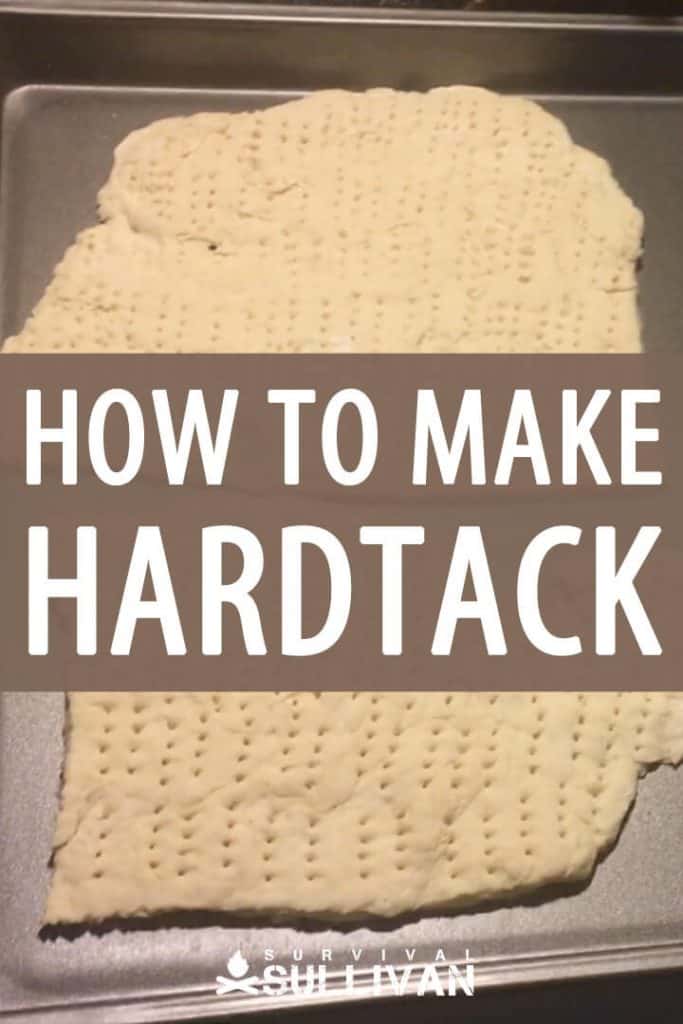

My name is Ryan Dotson and I am a survivalist, prepper, writer, and photographer. I grew up in the Ozark Mountains and in the foothills of the Pocono Mountains. My interest in survival started when I was in Boy Scouts and continued as my father, uncle, and grandfather taught me to hunt and fish. In the last few years I have started taking on survival challenges and have started writing about my experiences. I currently live in Mid-Missouri with my wife Lauren and three year old son Andrew.

Thank for posting about ( Hard Tack) now we have the basic`s , how about researching what would be the best tasting hard tack?. ask for people to send you their recipes . I never made hard tack but that`s about to change. again Thank you.
My husband and I did Civil War re-enacting and I thought it would be fun to make our own hard tack. I didn’t know about the 2nd 4 hour baking process in your recipe. I only baked it once. I used a hammer to break it down into crumbs for my camp stew, I also soaked it in coffee. However, one nice thing about hard tack is its versatility. It is so hard it can be used for plates for your flack jacket. Just kidding on that, but I’ll bet it could be done. We ended up adding some garlic salt to our hard tack and that made them more palatable. I sealed some up in my vacuum sealer and some in just a zip lock bag. That was probably 4 years or so ago and they’re still as hard as the day I put them in.
If HARDTACK was served in prisons; You’d have a RIOT to put down.